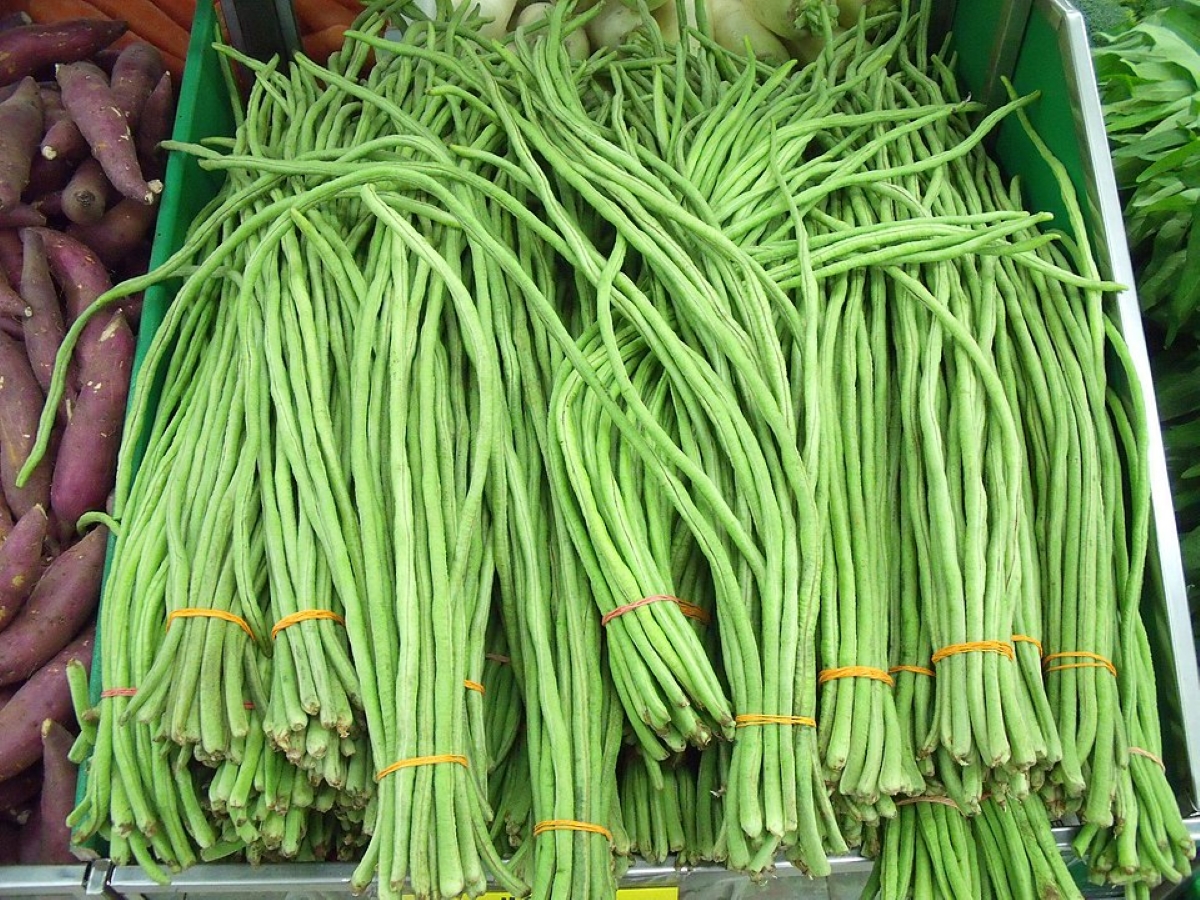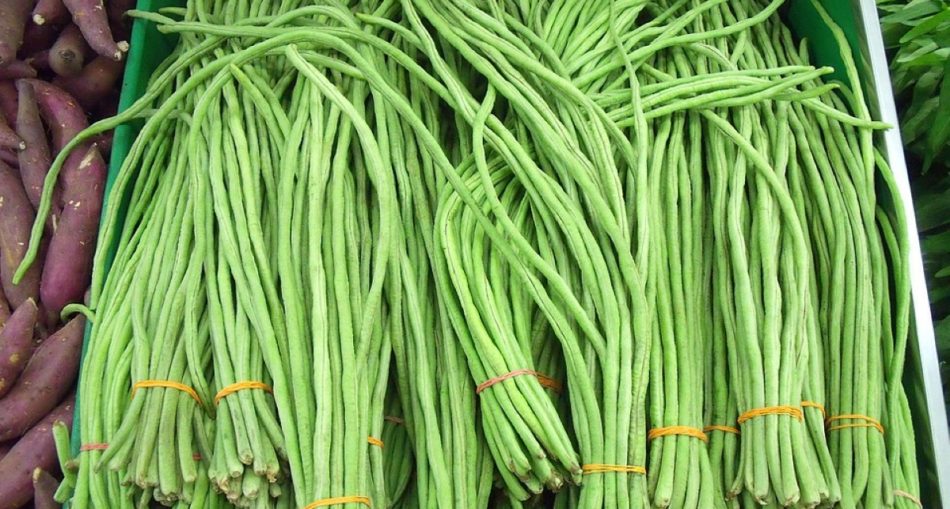Bodi bean, Long bean, snake bean, those are just some of the few names used when referring to the Chinese yardlong bean. But in some Caribbean countries including here in Guyana, it is commonly known as BORA.
So in this article I’m going to use the local name Bora instead of yard-long bean.
Bora is an annual and fast-growing plant which is cultivated for the long pods and edible seeds. It is a member of the legume family Fabaceae.
It is grown in home gardens and can be found at a number of stalls, markets and supermarkets across Guyana. It’s added to various foods such as- fried rice, chowmein, macaroni, salad and soups. It can be steamed or eaten just as it is- RAW! And also curried with (chicken, beef, pork, shrimp) and fried up with potatoes. It goes well with rice, sada roti and paratha roti. However you choose to eat it, it’s your choice. But it’s just simply delicious, whichever way it is cooked.

Bundles of Bora aka Long Beans – Photo By David – Own work (Original text: I created this work entirely by myself.), Public Domain, https://commons.wikimedia.org/w/index.php?curid=15721339
Origin Of Bora
Bora originated in Southern Asia but now is widely cultivated in Southeastern Asia, Southern China and Thailand. The beans are also grown in small scales in the home gardens in the Southern United States, West-Indies as well as in the Mediterranean regions. It grows in warm climates. While its leaves are consumed as vegetables,the young pods are cooked or consumed fresh and seeds are cooked as a pulse. The pods are picked before it gets matured and cooked as vegetables.
Description Of Bora
The Bora plant grows is an annual, smooth climber that can reach as high as two to four (2–4 ) metres in height. The plants produce vibrant green leaves about twelve to fifteen 12–15 cm and four to seven 4–7 cm wide. Flowers of the bora plant grows into long pods about thirty to one hundred (30–100) cm long. The pods are typically light green to dark green but some varieties are purple with either smooth or wrinkled skin. They contain about twenty to twenty-five (20-25) seeds. These seeds are cylindrical and about eight to twelve (8–12) mm long. The seeds also have different colours like brown, black, red, striped or white.
Nutritional Value Of Bora
A serving size of bora (100 grams) contains about forty-seven (47) calories, four (4) mg sodium (0% daily value), eight (8) grams of total carbohydrates (2% daily value), and three (3) grams of protein (5% daily value). It has no fat or cholesterol.
Here are 9 Healthy Benefits Of Bora
- Skin health – Bora contains Vitamin C which is necessary for skin, blood vessels, ligaments and tendons. Vitamin Creduces blemishes, wrinkles, dryness or skin and can even slow down ageing.
- Less risk of Gout – Vitamin C helps to lower the risk of gout, a condition which affects the big toe, caused by high uric acid, which forms crystals in the joints. PErsons consuming Vitamin C significantly reduces their chance of getting gout by thirty-one (31) percent.
- Rich in Folate– Foods rich in folate like Bora, helps to prevent cancer. Folate helps to reduce homocysteine, a buildup of protein that increases the risk of strokes and heart attacks. Folate is also essential in pregnancy, the lack of which can cause birth defects.
- Sound sleep – Bora provides a sufficient amount of magnesium, which soothes the brain and promotes relaxation.
- Source of Thiamin – Thiamine in Bora helps in the production of hydrochloric acid, that tones the digestive tracks. Thiamine can improve the signals of muscles and never, which is important in passing on information to the brain.
Common Uses Of Bora
- Sliced bora beans can be added to soups.
- There are many ways to prepare bora like, stewing, braising, sauteeing, and frying (deep or shallow).
- Pods can be cooked or eaten fresh.
- In the Chinese cuisine, bora is stir fried with potatoes and shrimp.
- Bora can be chopped and added to omelets for an extra crunch.
- The raw bora beans can also be added to salads.
Here is how to make Bora Curry and Chicken – Guyanese Style
Ingredients:
- 1/2 lb. Bora (long beans)
- 4 chicken drumsticks
- 1 1/2 tsp. curry powder
- 1 tsp. garam masala
- 1 tsp. roasted ground cumin
- 1/2 onion
- 2 stalk scallions
- 2 cloves garlic
- black pepper
- pepper ( optional )
- salt to taste
Method:
- Wash and chop bora and seasonings, set aside
- Chop garlic and pepper very fine or pound in mortar, set aside
- Strip meat from drumsticks, cut up, wash and set aside
- Make curry paste by mixing curry powder, masala, cumin and garlic and pepper with water
- Heat some oil and add chopped onions fry for approximately 1 mins. Stir to prevent burnin
- Add curry paste and cook for about 2 mins, stir to prevent burning
- Add chicken and cook for about 1 min.
- Add bora, salt to taste, the chopped scallions and some black pepper.
- Let cook, add a little water (just enough) as this curry is supposed to be dry like a bunjhal.
Watch This: Bora and chicken with potatoes
About Bora
Bora is an annual and fast-growing plant which is cultivated for the long pods and edible seeds. In Guyana, it is cooked either stewed, curried, fried with chicken, pork, beef and shrimp. It can be found all across Guyana. It is packed with numerous health benefits and is cholesterol-free.
Article References:
- https://en.wikipedia.org/wiki/Asparagus_Beans
- https://www.nutrition-and-you.com/yard-long-beans.html
- https://www.healthbenefitstimes.com/yardlong-bean/
Last Updated: 2020-07-09







